Computex 2005 Day 1 - ATI R520 Sighting, NVIDIA's new Chipset
by Anand Lal Shimpi on May 31, 2005 6:41 AM EST- Posted in
- Trade Shows
Day one of Computex has already been quite eventful; we've seen yet another working R520 demo performing some impressive H.264 GPU acceleration, as well as motherboards based on NVIDIA's new C51G. All that and much more in this Computex article...
The H.264 specification is particularly important as it will be the predominant encoding/decoding standard for both blu-ray and HD-DVD. Being able to accelerate H.264 encoding, decoding and transcoding will soon be the new focus of system performance. If you've played around with either encoding H.264 content or playing back the limited amount of H.264 content currently available, you know that the overall system demands for anything dealing with H.264 are quite high.
ATI is addressing one part of the problem by offering GPU-accelerated H.264 decoding with the R520. The demo was conducted on 25Mbps HD footage recorded using a HD video camera and played back on a Pentium 4 3.6GHz system (Hyper Threading enabled) with a R520 graphics card.
Obviously, the story of the day happens to be ATI's CrossFire multi-GPU solution, and ATI had some CrossFire demos running in their suite as well.
Just like all of the other chipset makers, ATI had a wall of motherboards based on ATI chipsets at their suite:
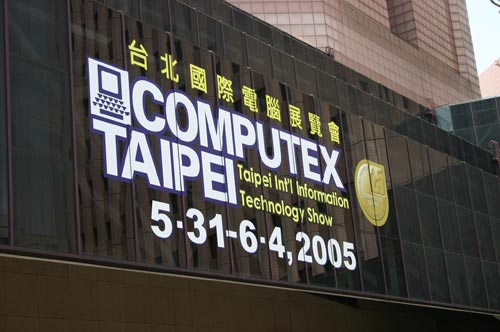
ATI Demos R520, Accelerates H.264 Decoding
ATI's R520 has made its second appearance in the past couple of weeks, this time behind not-so-closed doors at ATI's suite in the Hyatt hotel.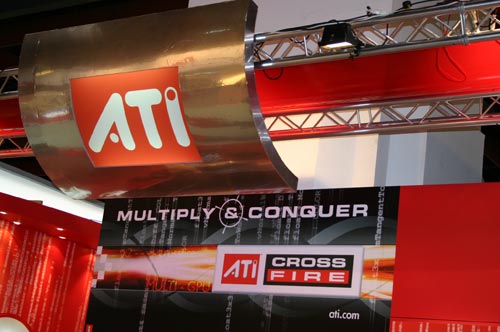
The H.264 specification is particularly important as it will be the predominant encoding/decoding standard for both blu-ray and HD-DVD. Being able to accelerate H.264 encoding, decoding and transcoding will soon be the new focus of system performance. If you've played around with either encoding H.264 content or playing back the limited amount of H.264 content currently available, you know that the overall system demands for anything dealing with H.264 are quite high.
ATI is addressing one part of the problem by offering GPU-accelerated H.264 decoding with the R520. The demo was conducted on 25Mbps HD footage recorded using a HD video camera and played back on a Pentium 4 3.6GHz system (Hyper Threading enabled) with a R520 graphics card.
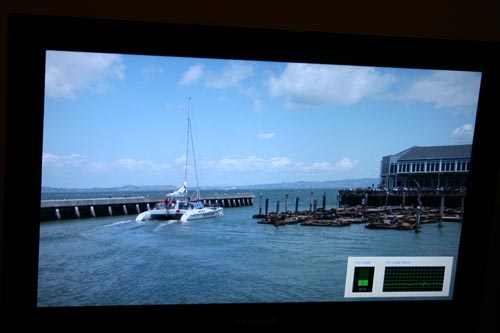
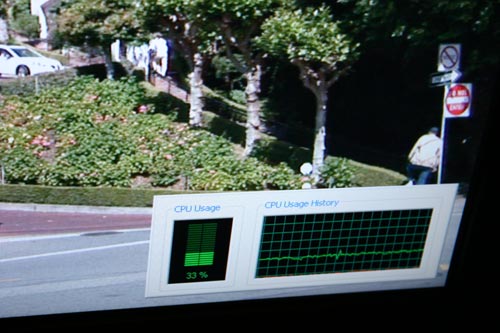
Obviously, the story of the day happens to be ATI's CrossFire multi-GPU solution, and ATI had some CrossFire demos running in their suite as well.
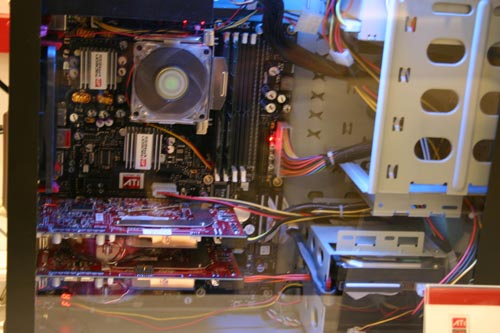
Just like all of the other chipset makers, ATI had a wall of motherboards based on ATI chipsets at their suite:
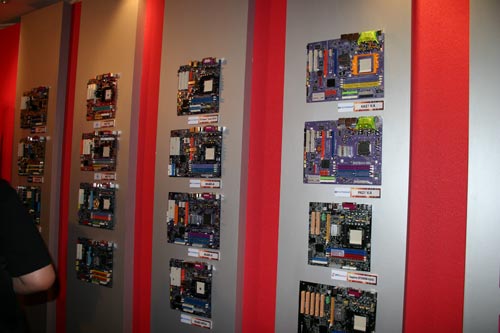










37 Comments
View All Comments
Calin - Wednesday, June 1, 2005 - link
stmok, the Mac Mini is more than a stylish case and a opensource operating system.Would you be glad to pay for the components to make a car? Just think about it, there are books you can borrow from library about every aspect of making a car.
Calin - Wednesday, June 1, 2005 - link
SoundStorm was a typical integrated sound solution, and its audio quality was no better than the quality of its digital to analog converters (which usually weren't very good).However, the digital output did made it by far the most desirable mainboard with integrated sound. Maybe only the mainboards with tubes were better than that, but that is a subjective thing with lots and lots of pro and cons (space, power use, heat and so on) having no relation to quality. Also, tube was just stereo, not multichannel
Reflex - Wednesday, June 1, 2005 - link
#24 - My only issue is this continued perception that Soundstorm and its on the fly DD encoding is a good thing for sound quality. Its not, its a lower quality method than analog outputs by a long shot. That said, for an integrated solution nothing can touch SS. But anyone who cares about sound quality won't be using integrated audio anyways, and once you get to add in boards there are plenty of quality non-Creative solutions.I'm not a Soundstorm or a DD hater. But I don't pretend they are something which they are not. SS was a low end sound solution, it was the best of the low end solutions, but there are $40 add-in cards that are better these days, so bemoaning its loss is a bit rediculous.
Gatak - Wednesday, June 1, 2005 - link
#18 I agree with you that compression is not good. AC3 is also even more difficult to properly encode than for example DTS. DTS also uses more bandwidth with less encoding. For most home users that would be good enough.You are right too that for Hi-Fi music/audio then uncompressed is totally unmatched. But usually the source you use is either two channel PCM, or already compressed multichannel in some manner. Either way you could stream both digitally without re-compression.
Of course, There is no true Audio-DVD reader for consumer PCs yet. So it is a moot point?
Reflex - Wednesday, June 1, 2005 - link
#18 -1) Not really, but even if it did it all depends on if your serious about sound quality, which is the issue I am addressing. Regardless, uncompressed sound is better sounding even on crappy cabling than compressed sound over a digital cable.
2) Depends on the card of course, there are decent sound cards that compete with nice amps, but you'll pay quite a bit for them. Once again though, a high quality amp is only going to amplify the crappy audio quality of the compressed signal. No matter how nice the amp it cannot make something sound better than the source.
3) If the compressed source is pre-encoded(ie: a DVD movie) where sound engineers are correcting for any glitches or excessive loss of range, than you would be correct. THe issue with Soundstorm is that it is encoding on the fly with no quality control or engineers listening for mistakes. For a movie or games thats fine, for music fidelity it is not.
4) Movie theaters and DVD's are using pre-encoded content, not on the fly encoding. The quality control can be done during the mastering process.
Googer - Tuesday, May 31, 2005 - link
#6 You can still have an SSD in iWILL's SFF, it would be installed in the 5.25" drive bay, It's called HyperDrive and can be found athttp://www.hyperos2002.com/
stmok - Tuesday, May 31, 2005 - link
my response was for poster #12.stmok - Tuesday, May 31, 2005 - link
You're willing to pay extra for a case that looks stylish (which means nothing to me), and an Operating System that is essentially open-source technology? (The same Unix technology can be downloaded for free and used on your typical x86 setup.)I use FreeBSD, (which is what Mac OS X largely consists of)...I only used up 2x 700MB CD-Rs...How much did you spend on a Mac Mini? Alot more than 1.4GB of monthly internet download, 2 blank CD-Rs, and some reading time, that's for sure.
Heck, even a variant of FreeBSD is under development...Its targetting for desktop users. Its called PC-BSD. I've been testing this, and it has alot of potential. (The simple "double-click to install" applications and Linux-binary compatibility is a nice touch).
You praise Steve Jobs for basically duping you into a pre-packaged platform that has a ridiculous price tag and a pretty GUI slapped ontop of freely available open-source software!
And don't say you're secure. A rootkit can change your tone on that issue as well.
We do many stupid things in life...We get drunk, we wake up next to a stranger (hopefully a good looker), we pull some pranks, we probably even ran over the next door neighbour's cat...In your case...You bought a Mac!
Now, with regards to the Iwill SFF dual CPU/Video card solution. Sure, its a cool package, but don't be too hyped up by it. Its predecessor had some issues that caused much headaches to owners.
My advice...Wait until they'll gone through at least one revision before spending this kind of money.
Opterons ain't cheap, neither is SLI. To spend much money on a system, only to be plagued by various causes of instability is not a path to satisfaction.
One thing I would like to see...A new approach to video card cooling.
With both ATI and Nvidia solutions taking up a total of 4 slots (2 by video cards, 2 by coolers), there isn't much left in terms of expansion is there?!
Why not a new solution that is relatively thin enough? What about that liquid metal cooling solution that Sapphire is playing with? Maybe a variation of that?
Could that be made to tame the thermal characteristics of a modern day GPU/VPU such that the video card only occupies 1 slot?
Shinei - Tuesday, May 31, 2005 - link
Boo, no G70 pimping on nVidia's part. I thought for sure they'd have at least one or two engineering samples set up to put the smack on ATI's H.264 decoding devices (PureVideo 2?)...ArneBjarne - Tuesday, May 31, 2005 - link
#161. 5 meters of analogue cabeling competing in quality with the digital transfer is going to cost some serious money.
2. The DAC's on those cards cannot compete with the ones in my home theater amp.
3. Although AC3 compression is lossy it is a controlled loss unlike the loss associated with the analogue transfer.
4. SS uses the lowest possible AC3 compression, (640 kbit/s), since space is not a concern. This is better than what is used in movie theaters (320 kbit/s) and on DVDs (most use 384kbit/s while 448kbit/s is the maximum). Personally i can live with a compression only half as hard as the one used in SRD :)